.
.
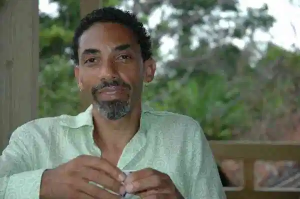
.Robin D. G. Kelley,
author of
Thelonious Monk: The Life and Times of an American Original
.
___
.
“The piano ain’t got no wrong notes!” So ranted Thelonious Sphere Monk, who proved his point every time he sat down at the keyboard. His angular melodies and dissonant harmonies shook the jazz world to its foundations, ushering in the birth of “bebop” and establishing Monk as one of America’s greatest composers. Yet throughout much of his life, his musical contribution took a backseat to tales of his reputed behavior. Writers tended to obsess over Monk’s hats or his proclivity to dance on stage. To his fans, he was the ultimate hipster; to his detractors, he was temperamental, eccentric, taciturn, or childlike. But these labels tell us little about the man or his music.
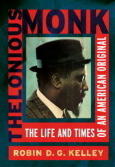 In the first book on Thelonious Monk based on exclusive access to the Monk family papers and private recordings, as well as on a decade of prodigious research, prize-winning historian Robin D. G. Kelley brings to light a startlingly different Thelonious Monk: witty, intelligent, generous, politically engaged, brutally honest, and a devoted father and husband. Indeed, Thelonious Monk is essentially a love story. It is a story of familial love, beginning with Monk’s enslaved ancestors from whom Thelonious inherited an appreciation for community, freedom, and black traditions of sacred and secular song. It is about a doting mother who scrubbed floors to pay for piano lessons and encouraged her son to follow his dream. It is the story of romance, from Monk’s initial heartbreaks to his lifelong commitment to his muse, the extraordinary Nellie Monk. And it is about his unique friendship with the Baroness Nica de Koenigswarter, a scion of the famous Rothschild family whose relationship with Monk and other jazz musicians has long been the subject of speculation and rumor. Nellie, Nica, and various friends and family sustained Monk during the long periods of joblessness, bipolar episodes, incarceration, health crises, and other tragic and difficult moments.
In the first book on Thelonious Monk based on exclusive access to the Monk family papers and private recordings, as well as on a decade of prodigious research, prize-winning historian Robin D. G. Kelley brings to light a startlingly different Thelonious Monk: witty, intelligent, generous, politically engaged, brutally honest, and a devoted father and husband. Indeed, Thelonious Monk is essentially a love story. It is a story of familial love, beginning with Monk’s enslaved ancestors from whom Thelonious inherited an appreciation for community, freedom, and black traditions of sacred and secular song. It is about a doting mother who scrubbed floors to pay for piano lessons and encouraged her son to follow his dream. It is the story of romance, from Monk’s initial heartbreaks to his lifelong commitment to his muse, the extraordinary Nellie Monk. And it is about his unique friendship with the Baroness Nica de Koenigswarter, a scion of the famous Rothschild family whose relationship with Monk and other jazz musicians has long been the subject of speculation and rumor. Nellie, Nica, and various friends and family sustained Monk during the long periods of joblessness, bipolar episodes, incarceration, health crises, and other tragic and difficult moments.
Above all, Thelonious Monk is the gripping saga of an artist’s struggle to “make it” without compromising his musical vision. It is a story that, like its subject, reflects the tidal ebbs and flows of American history in the twentieth century. Elegantly written and rich with humor and pathos, Thelonious Monk is the definitive work on modern jazz’s most original composer.#
Kelley discusses Monk and his book with Jerry Jazz Musician publisher Joe Maita in a December 28, 2009 interview.
.
.
___
.
.P
photo by William Gottlieb/Library of Congress
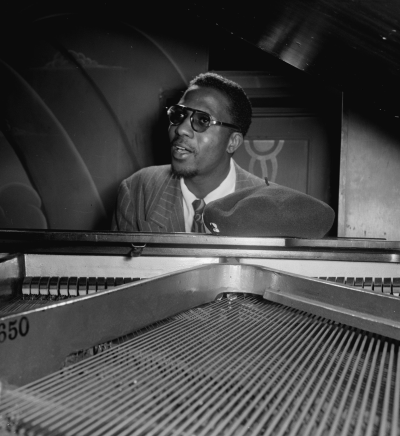
Thelonious Monk, Minton’s Playhouse, New York, N.Y., ca. Sept. 1947
.
___
.
“He demanded originality in others and he embodied it in everything he did: in his piano technique, in his dress, in his language, his humor, in the way he danced, in the way he loved his family and raised his children, and above all in his compositions. Original did not mean being different for the hell of it. For Monk, to be original meant reaching higher than one’s limits, striving for something startling and memorable, and never being afraid to make mistakes. Originality is not always mastery, nor does it always yield success. But it is very hard work.”
– Robin D.G. Kelley
.
_____
.
JJM Christopher Lydon recently wrote about your book in the Huffington Post, “There may be another jazz biography as thickly detailed, as audibly lyrical, as passionate, as thrilling as this one, but I can’t bring it to mind.” This is a common critique of your book, so congratulations, Robin, on your work.
RK Thank you.
JJM Who and what were some of your key sources for the book?
RK A key source was, of course, Monk’s family and their private archives. I am the only researcher to ever have had access to the family’s materials, which included things like Monk’s composition books, a composition book from high school, and original manuscripts. There was no correspondence or anything like that, but it included a few little gems here and there, and for the most part I found resources all over the globe. I found articles that I had translated from Polish, French, Portuguese, Spanish, Dutch, Swiss, Swedish, and so many other countries, and found rare documents in the United States in the most unusual places. But, the most important source for me were the memories of Monk’s family – the stories that they were able to hold on to. It is a large, close-knit family, and it was their willingness to openly share the stories that really made this book happen.
JJM How did the San Juan Hill neighborhood of New York City in which Monk grew up help shape his musical taste and ambition?
RK I think that it is essential. He was born in North Carolina but he left at such a young age – about four-and-a-half years old – and the San Juan Hill neighborhood became his world. It is located just west of Lincoln Center in a working class, multi-ethnic neighborhood. But, while it was multi-ethnic, it was also very segregated. Sixty-first, 62nd, and 63rd Streets were West Indian blacks and African Americans from the South. Amsterdam Avenue was mostly white ethnic, Irish, Italian, Jewish. The corners of the Avenues is where everybody met, and it was called San Juan Hill because the racial violence was so intense at times that it looked like a war zone. Nevertheless, Monk experienced a neighborhood full of musicians and a very close-knit community. It had a community center – which just about every kid in the neighborhood was a member of – where they were taught things like music, orchestra and band, elocution, basketball, tennis, table tennis, and just about anything you could imagine. And that was Monk’s world.
His best friends were mainly from San Juan Hill, and his best friend Sonny eventually became his brother-in-law. He only had three girlfriends in his entire life, all of whom lived within a two-block radius, which to me is astounding. This was also the community where he learned to play the piano. He had a private classical teacher name Simon Wolff, an Austrian Jew who taught violin and piano to virtually all of the black kids who could pay him 75 cents a lesson. This is where Monk learned to play Chopin, Rachmaninoff, and others. He also had another neighborhood teacher, Alberta Simmons, a wonderful stride pianist who taught him a lot about music, but also taught him what it means to be an entertainer. She really had an impact on him. Finally, he listened to so much music in that multi-ethnic black community – calypso, salsa, and other kinds of music just on the street – and some of it entered into his own music.
JJM You write about some of the racism that he encountered as a child. How did this affect his early years?
RK That is an interesting thing to consider, because while he experienced racism in school and witnessed violence in his neighborhood, he also experienced a great deal of love and support from the community. So Monk always de-emphasized racism. While he acknowledged there were fights in the neighborhood and things like that could happen, he would say that every time he tried to hate white people, he couldn’t because he saw so many exceptions.
What shaped his early years was the love and support he got from his mother and the community. He was also nurtured while he became engaged in the jazz world. There were plenty of bad club owners and band managers in the world, but Monk’s world was hanging out with older musicians at the great stride pianist James P. Johnson’s house, where they would teach him about music without ever taking a dime for it. He later opened up his tiny little apartment on West 53rd to any musician who wanted to come by and learn a tune or sit with him and talk or just play. That sort of generosity made the racism seem small to him.
JJM You always think of Monk as the musician, but did he have any career alternatives to music?
RK That is an interesting question because, after all the research I have done, as far as I know the only job other than music that Monk took was delivering ice for the local iceman. I believe he held that job for about two days – he wasn’t going to do that! So, for Monk there were no options to music, and the thing that is most amazing is that he was surrounded by women who agreed with him. His mother felt that if he wanted to play the piano, he should play the piano, and she made sure there was a piano in the house. She also made sure that he had a place to live – she never threw him out of the house. When he married Nellie, she basically did the same thing. She worked as a seamstress, she worked for Chock Full of Nuts, she did whatever it took to help them survive. So music was Monk’s only possible vocation. He was a brilliant man who could do many things, but he couldn’t conceive of anything other than playing music.
JJM Monk’s eccentricities and behavior are legendary. You wrote, “But not all of Monk’s bizarre actions were artifice. Thelonious suffered from bipolar disorder, the signs of which are evident as early as the 1940’s.” How did you arrive at this diagnosis?
RK Well, a combination of things. First, by having access and speaking to Nellie, who explained a lot of his conditions to me. By the 1970’s, they had the correct diagnosis and were treating him with Lithium, but it was not always clear what the diagnosis was throughout. So, access to the family, and access to the limited medical records certainly helped me. I also spoke to two of his doctors – one off the record – and from looking at his prescription receipts I know that he was taking Thorazine. From other sources I was able to learn when he was hospitalized and under what conditions.
The other thing is that his behavior indicated classic symptoms of bipolar disorder. The instances were episodic. Sometimes he would go months and months without an episode, so most musicians who knew Monk knew him as a fairly normal, humorous person. The stories that don’t get told are the stories of his sense of humor and engagement with the world. The stories that do get told are the ones where he checks out because they make better stories, as far as the press is concerned.
Another thing I argue in the book – which bugs some of the reviewers – is that some of his behavior was intended to be theatrical, as a way to protect his own privacy As he famously told the writer Frank London Brown, “You know people have tried to put me off as being crazy. Sometimes it’s to your advantage for people to think you’re crazy.”
But some of his behavior was neither stagecraft nor mental illness. Some of it – like being late for jobs, for example – was resistance against the kind of exploitation he experienced from club owners, the exception being the Five Spot. When he was late at the Five Spot it was because he sort of took advantage of his good friendship with Joe and Iggy Termini in ways that I think were unfair. For the most part he would show up late for gigs because he felt that he wasn’t being paid enough, and at times he would refuse to do matinees. But, for a working musician, this makes perfect sense.
The amazing, surprising and even shocking thing to me about Monk is how many times he didn’t miss a gig, and how many times he did arrive on time. That is a story that doesn’t get told as much because, you know, being consistent is not as interesting as being absent or being wild. So one of the things I try to do in the book wherever possible is document what his schedule was like, especially during the 1960’s when he was on tour all the time. It was grueling, and sometimes you are exhausted from reading about it, but that is exactly the point – I want you to feel exhausted because Monk was exhausted. Once you experience what it means to play in 20 cities in 30 days, and to be on the road living in hotels, you see just how rough it was. On top of that, here is a man taking prescription drugs, who is having issues with sleep but still has to make the gig, and you can see that he led a hard life.
JJM How much debate has this opinion inspired?
RK Well, there has been some debate. Downbeat had a review that basically said all the evidence in the book suggests that he really was crazy and that he really was eccentric. While I don’t deny that these stories happened, what I do say is let’s take a look at the whole picture of his life. So, my book wasn’t an effort to simply knock down the character of Monk as being “crazy” and “eccentric,” it was to put that part of his life in context. It was to understand how he ended up in Bellevue, or how he ended up in Grafton State Hospital. What was he going through? What was he feeling? And what about moments like those found in the film Straight, No Chaser, when he is filmed spinning around in circles in the airport? What was he trying to do, and what part of that was stagecraft? Here was a man who was very much aware of where he was, being very playful, and what ends up happening is that people interpret that behavior as him acting crazy, when in fact, he was giving the viewer a show. He wants you to say those things about him.
JJM Yes, as you pointed out earlier, he said, “Sometimes it’s to your advantage for people to think you’re crazy.”
RK Exactly, and Monk really believed it. While it worked to his advantage to a certain degree, it would come back to bite him because there were points where his reputation for being unreliable and taciturn and crazy made it difficult at times for him to get gigs.
JJM He was labeled a psychiatric reject by the Army…
RK He was, but I learned that the percentage of African Americans labeled as psychiatric rejects was incredibly high compared to any other group during World War II. So in some ways, Monk was in good company. There is great research out there that shows that the Selective Service didn’t want African Americans in the military, and were worried about their presence in it. On the other hand, there were those – and Monk was one of them – who deliberately presented themselves as being kind of crazy or challenging in order to avoid being drafted. For example, I wrote in the book about Malcolm X and Dizzy Gillespie doing that. Dizzy went into the draft board and told them that they really don’t want him in the Army because, given the fact that white people have been beating him his entire life, he might get out on the battlefield and shoot one of his own compatriots as a result of mistaken identity. He was subsequently classified 4F.
Monk’s story is that he went to the draft board and said something similar to what Dizzy said, that he couldn’t fight a white man’s war in this world where black people are treated so badly. While he didn’t want to fight, he was committed to supporting the French resistance. He would walk around Minton’s Playhouse wearing a beret and a “France Libre” button on his lapel to let the world know that he was for the resistance.
JJM Following a 1956 car accident, Monk was taken to Bellevue Hospital, where he was called a “psycho.” It was there that he began, as you wrote, to “exhibit classic symptoms of [bipolar] disorder – symptoms that would occur more frequently in the years to come.” What were his narcotics and alcohol use at that time?
RK Well, it wasn’t much different from other musicians of that era. He drank recreationally and worked at clubs where what they do more than anything else is sell alcohol. Everyone was drinking in those days – it was a hazard of the job. You watch most any film about the 1950’s and every day, these middle class white men in grey flannel suits would have a beer during lunch, and would then come home to a couple of Martinis, and then, before going to bed they would have a nightcap. So, the musicians were drinking as much as anyone else, the difference is that jazz musicians were stigmatized for their drinking. Monk used heroine intermittently in the ’40’s, but by the late ’50’s I find that he is not. Monk was almost carnival-esque in his use of narcotics – he did whatever he felt like doing at the moment, but he was never an addict.
Another thing is that the doctor who checked him out, Dr. Robert Freymann – who was the Baroness Nica de Koenigswarter’s doctor – was administering what he called vitamin shots to not only Monk but to all of his patients. It was discovered years later that those vitamin shots were laced with amphetamines. Now, imagine a few years later, in 1959, Monk goes to Grafton State Hospital in Massachusetts where they administer him Thorazine while he is taking these amphetamine-laced “vitamin shots,” while he is also drinking whenever he feels like it, and while he was occasionally taking bennies. So the combination of these things exacerbated what was already a chemical imbalance in his system, and when he had his ups, he was up, and when he was down, he was down.
JJM How did the narcotics affect his social relationships?
RK The impact on his social relationships was less about narcotics and more about the poverty. You know, rich people who drink or use narcotics generally have a job, so they have resources for this, but Monk never really made a living from the middle 1940’s to 1957. He didn’t start making a living until he was 40 years old, which is significant. His wife worked very hard for him – she was not the only bread winner, but she was the primary bread winner, and Monk had to do what ever it took. In 1951, after he lost his cabaret card for the second time, he couldn’t play in Manhattan where alcohol was served, so he took gigs out in Brooklyn and the Bronx, playing in black-owned clubs. He hustled to get whatever gigs he could get. He played at cocktail parties and Bar Mitzvah’s and got the 10 or 15 bucks, taking whatever he could because he was so committed to his wife and family. The frustration he felt around his inability to get producers and club owners to really hear his music and appreciate it had more of an impact on him than anything else.
JJM A signature moment in his musical career was being hired by the drummer Kenny Clarke as house pianist at Minton’s Playhouse. What did Clarke see in Monk to hire him?
RK Well, Monk wasn’t even Clarke’s first choice. His first choice, Sonny White, couldn’t take the gig, so Monk ended up getting it. In those days – and this is very important for readers to recognize – Monk wasn’t seen as so strange. In 1940 he was hanging out with some of the greatest pianists in the city of New York. Folks like James P. Johnson and Willie “The Lion” Smith really respected Monk’s skills as a pianist, and they encouraged him to be who he is. No one said, “Oh man, look at Monk, he is so weird and strange!” When you listen to those early recordings from 1941, you hear people in the audience shouting Monk’s name, “Monk! Monk!” There is a response to him that suggests that he was actually beloved, that people respected what he was trying to do. He played slightly different but you can still hear Monk. There was something powerful about him. He also had an encyclopedic knowledge of the music, and he was a good band leader. And, while he brought a new harmonic sensibility to the music that the modern players loved, if you listen to those early recordings, you can hardly call it bebop. No one was really experimental. They were making a gig, they were just playing music for the people. There were backup singers and they were entertaining crowds and doing whatever it took to play music that was actually palatable for a Harlem lower working class audience. So, Monk fit really well in that environment.
JJM In 1939, the pianist Teddy Wilson said, “Thelonious Monk knew my playing very well, as well as that of [Art] Tatum, [Earl] Hines, and [Fats] Waller. He was exceedingly well grounded in the piano players who preceded him, adding his own originality to a very sound foundation.” And, the pianist Herbie Nichols was an early fan of Monk’s, saying that he would rather hear Monk play a stride piano piece than anyone else.
RK We know Herbie Nichols as one of the great composers of the music and a wonderful piano player who basically died broke because he never got his dues, but he also deserves credit for being the first critic to ever write about Monk. Although they were very different, Herbie and Monk, in a way, led parallel lives. Like Monk, Herbie Nichols was born and raised partly in the San Juan Hill area, and, like Monk, he was also once a house pianist – at Monroe’s Uptown House in Harlem. Nichols would go to Monk’s house and hang out a little bit, where they enjoyed each other’s company. Herbie wrote the first critical piece on Monk, praising him and his musical style, and then wrote the first long magazine piece in Rhythm magazine in 1946. So, Herbie Nichols understood what Monk was doing and promoted his music long before any of the other critics.
JJM The fame of Minton’s house band didn’t translate into any outside gigs and recording contracts for Monk. Why not?
RK Because he wasn’t there for that long. He was the house pianist there from January of 1941 through mid-summer, when he was fired, partly because he would be in the kitchen, lost in his writing. They would look all over for him and ask, “Where’s Monk?” There were other reasons too. Once World War II broke out, it had an impact on the whole scene in Harlem. Minton’s as a business was struggling, and the federal government was cracking down on some of the uptown clubs, including the Savoy Ballroom, which closed down. So, it was hard for anyone to sustain work. But he took whatever work he could, finding gigs at little clubs like Kelly’s Stable in Manhattan. But it really wasn’t until Coleman Hawkins hired him in 1944 that Monk got a regular gig, and he worked with Hawkins for quite some time.
JJM Meanwhile, while Monk was struggling financially and unable to secure regular work, Dizzy Gillespie and Charlie Parker became sensations. Monk felt that his music was being stolen and played by other people without himself benefiting financially. How did this affect their friendship?
RK It is an interesting question because, on the one hand, there is no question that there was tension between Dizzy Gillespie and Monk because Dizzy, more than anyone else, was getting the financial rewards and accolade for being the inventor of bebop – along with Bird. The critic Leonard Feather was a big promoter of Dizzy Gillespie at the expense of Monk, and I think he played a role in putting a wedge between those two. In his book Inside Bebop, Feather basically dismisses Monk as not being very interesting, and said his contributions to the creation of the music were unimportant. Meanwhile, he praises Dizzy as being the greatest thing since sliced bread, which pissed Monk off. Now, did Monk take it out on Dizzy? No. In fact, they hung out together, and Dizzy hired Monk to play in his big band in 1946 for a while, until Monk was late one too many times and Dizzy fired him. Whatever jealousy that might have existed between them certainly didn’t affect their ability to work or play together, and throughout the book there are moments where Dizzy might be in town and Monk would visit him. Monk kept a photograph of Dizzy Gillespie in his room, basically signed “To Monk,” so, Monk was the kind of person who, if he had a beef with you, he would tell it to your face. He would never keep anything to himself – he would tell you if he thought you did something wrong, if he couldn’t stand your music, if you stole something from him. But after, he would still hang out with you.
JJM He was certainly suspicious of Dizzy, though. At one point he felt that Dizzy got him a job with Lucky Millinder because he wanted to keep an eye on what Monk was doing so he could steal more of his ideas.
RK Exactly, and I am sure that Monk told Dizzy that. It is true that Dizzy and his arranger Gil Fuller loved Monk’s music, and his tunes were the ones they really wanted to arrange for big band. So, they wanted Monk around, even if they didn’t appreciate his piano playing. That is the other irony, that they brought Monk into the big band but you can hardly hear him play on the recordings. But they certainly wanted to have tunes like “‘Round Midnight” and “Playhouse” – which we now know as “Introspection” – arranged for big band.
JJM You wrote, “Nineteen forty-eight became the year Thelonious Monk was invented.” How so?
RK Monk was signed by Blue Note Records in 1947. They were the first record label willing to record him as a leader, and by this time he was 30 years old. The owners of the record label were Alfred Lion and Francis Wolff, and Lion’s wife Lorraine was sort of like a one-woman publicity machine at Blue Note.
They got involved with Monk around the time that the photographer William Gottlieb wrote the first article on Monk, called “Genius of Bop,” published in a mainstream magazine, Downbeat. The piece was short, and the hook of it was to discover this eccentric guy who started the music called bebop. He actually referred to Monk as the “George Washington of bebop,” which I love! He said that Monk is the guy who started it but you don’t know who he is because he is so mysterious, he is so eccentric and underground, and that he had to go track him down. So, it is a good story, and it created a sort of myth about Monk that Blue Note saw as a selling point. Lorraine Lion essentially took a page from Gottlieb’s article and wrote a press release emphasizing Monk’s mysterious qualities and nature, and told anecdotes about how he would go days and days without sleeping, knocking on people’s doors at all hours to play their pianos, how he would crash in their homes for a couple of days. All of this strange behavior was not written in a derogatory sense, she was just trying to make him interesting. It was a classic case of media manipulation that had some truth to it, because part of this behavior she described was tied to his bipolar disorder.
What is astounding to me is that from that point on, virtually every critic or writer who did a profile on Monk repeated many of the same things from Lorraine Lion’s press release. There were a flurry of articles profiling Monk that came out in 1948 – from both the black press and the mainstream press – all of which quoted things from the press release. From that point on it became the imprint of who Monk is.
JJM They really took the bait…
RK They sure did, and it worked for a minute. He was getting some good press until his arrest for marijuana possession – serving thirty days in jail and losing his cabaret card for a year as a result – and he wasn’t really resurrected until the 1950’s.
JJM While this publicity strategy helped Blue Note get press for Monk, it didn’t help them sell records, did it?
RK It sure didn’t, and there are two reasons for that. The first is that critics didn’t like Monk’s music. It is amazing how much power the jazz critics of the time had. Downbeat or Metronome or any of the jazz magazines never had anything good to say about Monk’s music. The only critics who said he was doing anything interesting were Herbie Nichols and Monk’s friend Paul Bacon, who was actually the art director for Blue Note at the time, so given that personal relationship the review could be questioned. There were a couple of Swiss critics who wrote an article in French that praised Monk in 1949, but no one in New York was reading those reviews. A young Orrin Keepnews wrote a strong article praising Monk in Record Changer, but no one was really reading Record Changer. So, the critics not being impressed with Monk was the first reason that he didn’t sell records, and the second is that Blue Note was still wedded to 78 RPM recordings in an age of 33 1/3 and the ten inch LP. Some record stores didn’t even offer 78’s any more, which didn’t help Monk’s record sales. Nevertheless, Blue Note continued to be committed to Monk and kept recording him until 1952, which was the year of his last recording for the label as a leader. So they were committed to Monk but they didn’t make much money off of him. Today, they make money off of him.
JJM Blue Note attempted to turn Monk into a commercial artist, doing things like setting him up with Milt Jackson and changing his rhythm section. And then Bob Weinstock of Prestige signed Monk. How did his vision for marketing Monk’s music and persona differ from that of Blue Note’s?
RK Weinstock had a different philosophy. Blue Note believed in rehearsals and in having arrangements, whereas Weinstock wanted to make good, decent quality jazz records that swung at the lowest cost possible. He wanted the musicians to come into the studio and make up the song and the recording on the spot, all in one or two takes, and if it turned out good, then fine – whatever. So Weinstock created these blowing sessions, while Monk came out of a tradition of actually writing difficult music that you really need to be up to par to play. He put out wonderful records on Prestige but they didn’t sell so well.
The other thing that was different is that once he recorded Monk, he began to use him as a side man, and one of his most famous recordings was with Miles Davis, Milt Jackson, Kenny Clarke and Percy Heath. It was an all- star cast, with Miles as the leader, and it was Weinstock’s effort to push all of his artists out there. Monk didn’t really last very long with Prestige, recording for about three years, from 1952 – 1955. That is when Riverside signed Monk.
JJM His 1956 Riverside recording, Brilliant Corners, received critical acclaim, and was labeled by some critics as “modern music.” So, it was during his time at Riverside that he began to be recognized as a great composer and a great contributor to the art…
RK Exactly, and I would add that it was Monk who got Riverside started on the path of being recognized as a great label. Before Monk their modern artist was pianist Randy Weston, who really delivered Monk to Riverside, despite what Orrin Keepnews or others may say. Keepnews and Bill Grauer owned Riverside, and when they first started, were doing things like recording the sound of Ferraris, which appealed to the single, hip, urbane male who liked to listen to the new novelty of high-fidelity recordings. They made a lot of money off of that – enough to be able to invest in jazz – so they recorded some of the older musicians, as well as modern artists like Weston and Monk. Even before signing with Riverside, Monk had already developed a reputation in the clubs as well as on some of the Prestige recordings he made with Miles Davis, for example, which did pretty well. Keepnews’ strategy for Monk was to have him make his first LP a recording of standards that he could interpret and put his imprint on, and, for the second album, it would be Monk Plays Duke Ellington. The idea was to make Thelonious Monk palatable to a broader audience. Part of that theory was that no matter what Monk played, he was going to sound like Monk.
Monk was all for these ideas. He was very invested in his career and took part in conversations about what to do, so if someone had a good idea for him, he would follow through on it. The Ellington album is a classic, and what he was able to do in a trio setting with Oscar Pettiford and Kenny Clark is just fabulous. So, by the time he gets to the third album, the now-famous Brilliant Corners, it is all of Monk’s own compositions, and it is no longer just a trio, but rather a quintet with Sonny Rollins and the great Ernie Henry on saxophone, Max Roach, Pettiford, and Monk. “Brilliant Corners” is a challenging composition – 36 bars with a seven bar bridge – and a strange song that shifts tempos. It was so challenging that even these great artists had trouble with. Keepnews tells the story of doing 25 takes, and then mixing them together to record one take.
So, Brilliant Corners was in some ways his breakout record, but I must also emphasize this recording coincided with him getting his cabaret card back, working at the Five Spot Café, and having a visible presence on the jazz scene not only in New York, but in the outer boroughs as well. All of these things combined in a way that helped him sell records and build his reputation.
JJM Was it during this era – particularly when he was playing to such acclaim at the Five Spot – that he began to understand his potential as a celebrity?
RK Yeah, but it is a tricky issue because Monk never lacked confidence, and his celebrity was more like a wave. In the spring of 1941 he was kind of a celebrity while playing at Minton’s, and then he disappeared. Then he was with Coleman Hawkins, and then he was out again for a while. Again, during that period in 1948 when he was in the press everywhere, he had some celebrity. 1957 was a period when, for the first time in his life, as a leader, he had his longest term gig ever. For six months straight he worked at the Five Spot, and everything was going really well for him – he had regular income, Nellie no longer had to work, and he got gigs traveling the country.
So, all of this great stuff is happening! But, a year later, during the fall of 1958, he’s beaten by the police in Delaware on his way to a gig in Baltimore, and as a result of him trying to defend himself, he ends up being fined and convicted of disturbing the peace, which results in him once again losing his cabaret card, this time for basically a year-and-a-half. It wasn’t his downfall, but it was just another blip in what was an upward trajectory.
JJM The incident in Delaware was a racist confrontation, where he and the Baroness were trying to get a glass of water from a motel proprietor…
RK Yes, in October of 1958, the Baroness was driving Monk and Charlie Rouse through Delaware, on their way to Baltimore for a gig. They stopped at a motel because Monk was thirsty and wanted a drink of water, and Nica didn’t realize that Delaware was still kind of Jim Crow at the time. So, the people in the motel office didn’t appreciate Monk’s presence, but he didn’t want to leave until he got some water. They called the cops, who came running in and dragged him out, roughed him up a little bit, and then let him go. They followed them down the highway and pull them over, got back-up assistance, and then pulled Monk out of the car and beat him severely with billy clubs while Monk fought back. They ended up being brought in, and the cops did an illegal search and seizure of the car – no warrant or anything – and found a trace of marijuana in Nica’s purse. They tried to convict her on marijuana possession, but the case was thrown out because it was a complete violation of her constitutional rights. She never saw a day in jail. So, Nica doesn’t really suffer, but the person who did was Thelonious. Despite the fact that he was he was perfectly justified in his effort to defend himself for being beaten, he was still convicted and fined. While he never saw a day in jail, the NYPD, who controlled the cabaret licenses, took his card away again, and he didn’t get it back again until early 1960.
JJM Of journalist Barry Farrell’s Time magazine’s article on Monk and its impact on jazz, you wrote, “While praising Farrell for writing an accurate, well rounded portrait, in depth of a complex personality, [prominent jazz writer] Leonard Feather nevertheless concluded the essay might actually harm jazz and race relations.” We know that Leonard Feather had an issue with Monk, but why did he feel that this article could harm jazz and race relations?
RK There are two reasons. Leonard Feather sort of took the bait about Monk’s character and felt he was not the best role model for jazz. He felt there were all these other role models that Farrell should have written about, like Oscar Peterson, like Dizzy Gillespie, and others who were in fact not doing drugs or drinking, who didn’t wear funny hats, and who didn’t engage in strange behavior. So he was basically saying that jazz needed a more respectable musician on the cover of Time magazine, not a crazy one like Monk. But, as far as Feather was concerned, that is what Time was interested in. The other reason too is that since Time reached a non-jazz and predominantly white audience, having the image of Monk on the cover would reinforce the stereotypes whites had for black jazz musicians. But what Feather doesn’t do is question the authenticity of Farrell’s piece which Ralph Gleason, the jazz critic in San Francisco, does. Gleason was saying that the article wasn’t even correct, and went after Farrell in a way no other critic did.
JJM And the piece was written at an interesting time, on the cusp of the civil rights movement, originally scheduled to be published the week of Kennedy’s assassination. It got moved back to the spring of 1964…
RK That’s right, and Barry Farrell himself was fascinated with the question of race in music because I believe he wrote an unsigned piece as the music critic for Time called “Crow Jim and Jazz,” which discussed how, in his opinion, white jazz musicians were struggling to get work, and described the black jazz musicians he identified as angry and revolutionary, and whose radical music had no place in jazz. The fact is that Monk’s Time profile emerged at a really hot moment when, on one side was the jazz avant-garde, which fairly or un-fairly was being identified with black nationalism and radicalism, and on the other side were the older swing musicians who were seen as conservative. These characterizations were not necessarily accurate but what they did is embody a political debate that was going on in the nation at the time – and Monk sort of gets caught in the middle. It is so ironic that a right-wing, conservative publication like National Review claimed Monk as their man because he knew how to swing, at the same time that a left-wing publication out of Harlem like Liberator claimed him as their guy, describing him as a revolutionary being exploited by the Baroness. So, it is fascinating how Monk became a symbol that people could write their own political agenda around.
JJM And before that he was a symbol to the artistic community as well. The beat artists, for example, really dug Monk. You wrote, “They found in Monk’s angular sounds and startling sense of freedom a musical parallel or complement to their own experiments on canvas and in verse.” So, he had this history of being a symbol of several different movements.
RK Absolutely, and, in fact, I would argue that the beat generation’s writers, poets and painters helped put Monk on the map.
JJM As Monk’s health deteriorated, was his downward emotional spiral ever evident in his recordings? We know he made some bad musical choices – like the Oliver Nelson arranged album, Monk’s Blues, is considered a bad choice – but I doubt we can pin that on his emotional state of mind…
RK No, in that case the bottom line is that he was very committed to doing what it took to make some money. Surprisingly, it is amazing how little his emotional state affected his recordings. There are a couple of moments when he is clearly struggling, like on the live recordings at the Jazz Workshop in San Francisco when he forgets what he played and plays another song. It could be that it was deliberate, but I doubt it was. But that is very rare.
What amazed me is his recorded output is consistently quality music, even when he was fatigued and struggling. For example, you listen to his recording of Duke Ellington’s “I Didn’t Know About You” from Straight, No Chaser from about 1967, and his piano introduction and solo is just outstanding, as are all of his solo recordings for Columbia, when he was really struggling. And by struggling I don’t mean struggling with his mental health, because most of the time he was quite cool and it was not an issue. But he was struggling with fatigue as a result of working so damn hard and not getting enough sleep, and he was struggling with physical issues – he had frequent colds and flu and had a lot of congestion due to the medication he was taking. He also had an enlarged prostate. If you look at the films of him playing during the 1970’s versus films of him playing with Count Basie in Japan in 1958, you will see that his body was moving constantly with Basie. His feet are moving, his body is moving, he’s dancing at the piano bench. Later on he is hardly moving, and that lack of movement is not mental, it’s physical – it’s his prostate. He is struggling with incontinence, he is uncomfortable, his fingers are stiff, his body is stiff, and he gained some weight. This is just old age! It’s that, plus the fact that later on the medication does affect him, so he does eventually “check out.” But I think the physical manifestations really have more of an impact because if you listen to those great London recordings from 1971, despite all that he is dealing with, you will hear that he hasn’t lost a beat, he still has his chops. It isn’t really until 1976, on his last recordings, where you can see that he is really struggling with the piano – it is really stiff for him and you can tell that his physical capacity is starting to be limited. That was the point where he decided he was done because he knew when he couldn’t play anymore.
JJM He was treated by Doctor Carl Pfeiffer, the director of the Brain Bio Center in Princeton, where you say he “improved dramatically”…
RK From all the evidence that I could put together, he started to go the Brain Bio Center in 1976 or 1977, which would have possibly been after his last concert. Saying he “improved” is tricky because his mental illness stabilized – the episodes of highs and lows kind of disappeared with the lithium treatment – but his physical health didn’t. He was able to take walks but an enlarged prostate is a real issue. He was sickly, and he was exhausted. So, I think he got tired of playing.
JJM He never had prostate surgery?
RK Well, I don’t think it was significant enough. He was taking medication, but as far as I know he never had surgery for it. Prostate issues in the middle 1970’s were known about, but not like today. You know, today everyone is on Flomax.
JJM Yes, that was forty years ago…
RK He never had to wear Depends for incontinence or anything like that. But it got him to move to the second floor of Nica’s house in 1973, and what worked about that is that he had his own room, with a bathroom next to him, and the piano upstairs. So, everything he needed was right there – it was his own little world. Getting to the bathroom was important because it made him comfortable and feel safe. He liked to lie in bed – he always liked to lie in bed, and at this point it became his vocation.
JJM There is so much to cover with a figure like Monk – it dawned on me we haven’t talked nearly enough about his music.
RK There is a great deal to discuss, yes.
JJM What do you want readers to take away from their experience of reading your book?
RK Probably three things. One is, I want them to know how Monk was made, what the context was that produced this genius. He didn’t come out of thin air – he came out of a close-knit, deeply cultural and intellectual community of working class people. The second thing is that I want people to be inspired to run to his music, to let my book be the opening of their own exploration of one of the greatest American composers of the twentieth century, someone who I put up there with people like George Gershwin, Charles Ives and John Cage. The third thing is to really understand his suffering. This is a story about a man who produced music that was so irreverent and humorous that you can’t help but laugh when you listen to it, but, he also had so many hurdles to jump over, like so many other musicians have had to. It is important to understand the number of gigs he had to play without making much money, his grueling schedule, the disappointment, the back pedaling –just following the money really teaches us what musicians were up against. I am just amazed that they were able to create this music under those conditions. Monk was actually one of the lucky ones. It is the ones we don’t know about who probably suffered just as much if not more than Monk who we need to pay attention to as well.
.
___
.
photo by William Gottlieb/Library of Congress
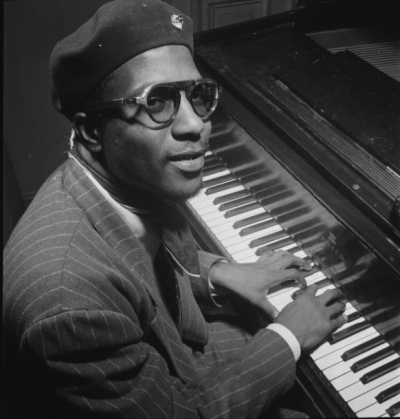
Thelonious Monk, Minton’s Playhouse, New York, N.Y., ca. Sept. 1947
.
*
.
“…for all the accolades and formal recognition, for all the efforts to canonize Monk and place his bust on the mantel alongside Bach and Beethoven, we must remember that Monk was essentially a rebel. To know the man and his music requires digging Monk – out of the golden dustbins of posterity, out of the protected cells of museums – and restoring him to a tradition of sonic disturbance that formed the entire world to take notice. He broke rules and created a body of work and a sound no one has been able to duplicate.”
– Robin D.G. Kelley
.
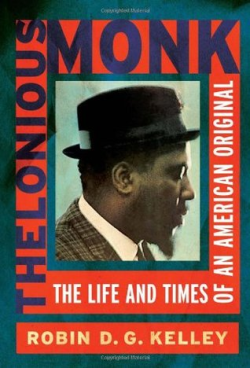
Thelonious Monk: The Life and Times of an American Original
by
Robin D.G. Kelley
.
*
.
About Robin D. G. Kelley
Robin D. G. Kelley is Professor of History and American Studies at the University of Southern California. His books include Race Rebels: Culture, Politics, and the Black Working Class and Freedom Dreams: The Black Radical Imagination. He has written on music for the New York Times, the Village Voice, Jazz Times, Lenox Avenue, The Nation, and other publications. He lives with his family and his Baldwin baby grand piano in Los Angeles.
.
__
.
JJM Who was your childhood hero?
RK My mother, Ananda Sattwa, was – and is – my hero in so many ways. She introduced me to jazz music. As a single mother with virtually no income, she used to take me on the subway for trumpet lessons with Jimmy Owens when I was about seven years old. She did everything possible to give us an education while living in a tenement house on 57th Street and Amsterdam Avenue in Harlem. And, I have to say that I feel like I got a better cultural education and better nurturing than a lot of kids who attended the most exclusive private schools. That was extremely important. My mother just finished up her Ph.D. in Ethnic Studies at U.C. Berkeley.
JJM You spoke at her graduation ceremony, didn’t you?
RK That’s right. I was the keynote speaker and had the privilege of “hooding” her, which is kind of a medieval thing where a recipient of a Ph. D. is given a hood. It was a great honor for me. I am very proud of her, and I still talk to her every day. My mother handed me Monk – she gave me Monk. I wouldn’t know anything about Monk if it wasn’t for my mother.
.
*
.
Critical Acclaim for Thelonious Monk: The Life and Times of an American Original
.
“Monk’s story, from roots in slavery, to the Great Migration north, to the cultural explosions of the 40s, 50s, and 60s, encapsulates a vivid tableau of twentieth-century American life and music. This biography is, at its best, a fitting tribute to one of America’s most original and lasting creative geniuses.”
.
– The Sacramento Book Review
.
“…extraordinary and heroically detailed…I doubt there will be a biography anytime soon that is as textured, thorough and knowing as Kelley’s. The “genius of modern music” has gotten the passionate, and compassionate, advocate he deserves”
– August Kleinzahler, The New York Times Book Review
.
“An omnibus of myth busting.”.
-Ben Ratliff, The New York Times
.
“…a massive and impressive undertaking…Thoroughly researched, meticulously footnoted, and beautifully crafted, “Thelonious Monk” presents the most complete, most revealing portrait ever assembled of the man known as the high priest of bebop”
– Steve Greenlee, The Boston Globe
.
__
.
.
This interview took place on December 28, 2009, and was hosted and produced by Jerry Jazz Musician editor/publisher Joe Maita
.
.
# Text from publisher.
.
.
.




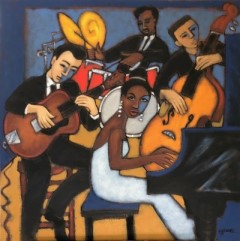
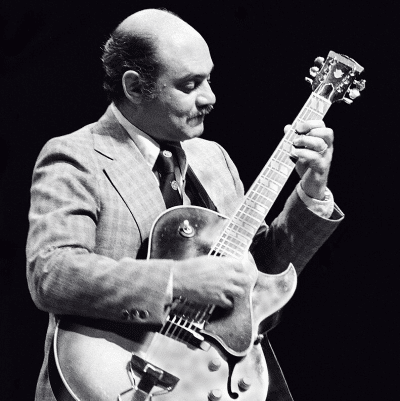
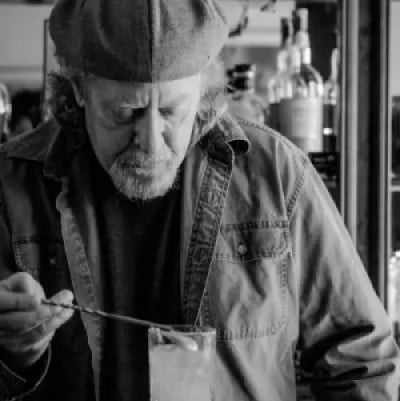


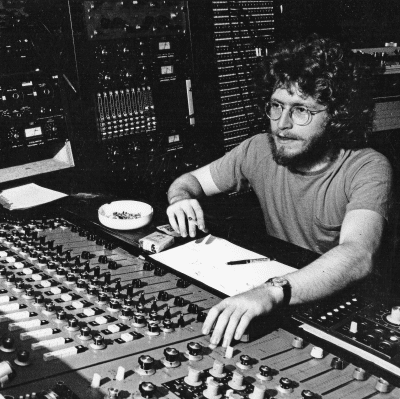
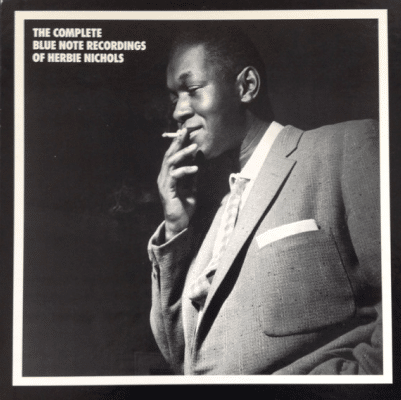
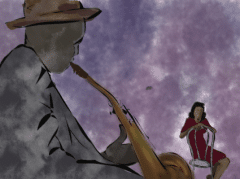

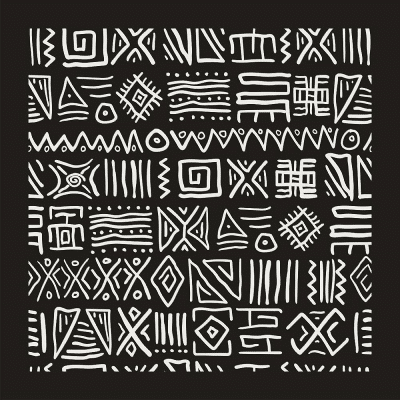

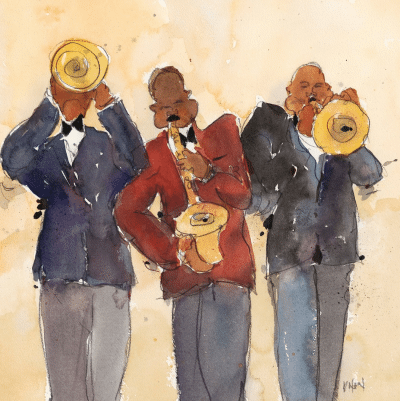
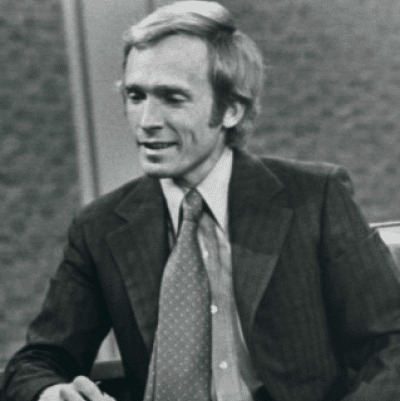



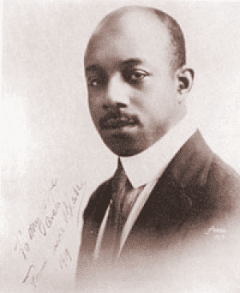


One comments on “Robin D.G. Kelley, author of Thelonious Monk: The Life and Times of an American Original”